Invented by Moshe Rubin, Daniel Schreiber, Kioba Processing LLC
Copy protection refers to the measures taken to prevent unauthorized copying or distribution of digital content such as movies, music, software, and e-books. It aims to safeguard the rights of content owners and ensure that they receive fair compensation for their work. The system and method for copy protection of displayed content play a vital role in achieving this objective.
One of the key drivers of the market growth is the rise in digital piracy. The ease of sharing and distributing content online has led to a surge in copyright infringement cases. As a result, content creators and distributors are increasingly investing in robust copy protection systems to safeguard their content from unauthorized access and distribution.
Moreover, the growing popularity of streaming services and digital platforms has further fueled the demand for copy protection solutions. These platforms rely on secure content delivery to ensure that only authorized users can access the content. The system and method for copy protection of displayed content provide a secure environment for content delivery, preventing unauthorized copying or redistribution.
Another factor contributing to the market growth is the increasing adoption of digital rights management (DRM) solutions. DRM technologies enable content owners to control the usage, modification, and distribution of their digital content. The system and method for copy protection of displayed content are an integral part of DRM solutions, providing a comprehensive approach to protect intellectual property rights.
Furthermore, the proliferation of high-definition (HD) and ultra-high-definition (UHD) content has necessitated the development of advanced copy protection systems. These systems employ encryption techniques and digital watermarking to prevent unauthorized copying and ensure the integrity of the content. As the demand for high-quality content continues to rise, the market for copy protection solutions is expected to witness substantial growth.
In addition to the entertainment industry, other sectors such as education, healthcare, and corporate enterprises are also driving the demand for copy protection solutions. These sectors deal with sensitive and confidential information that needs to be protected from unauthorized access or distribution. The system and method for copy protection of displayed content provide a secure platform for sharing and distributing such information, ensuring that it remains confidential and protected.
However, the market for copy protection solutions faces certain challenges. One of the major concerns is the balance between copy protection and user experience. While content owners aim to protect their intellectual property, users expect a seamless and user-friendly experience. Striking the right balance between security and usability is crucial for the success of copy protection systems.
Moreover, the constantly evolving nature of technology poses a challenge for copy protection solutions. Hackers and pirates are constantly finding new ways to bypass copy protection measures, necessitating continuous innovation and updates in the system and method for copy protection of displayed content.
In conclusion, the market for system and method for copy protection of displayed content is witnessing significant growth due to the increasing demand for secure content delivery and the rising concerns over copyright infringement. Content creators and distributors are investing in robust copy protection solutions to safeguard their intellectual property rights. As technology continues to advance, the market is expected to witness further growth, driven by the need for advanced copy protection systems in various sectors.
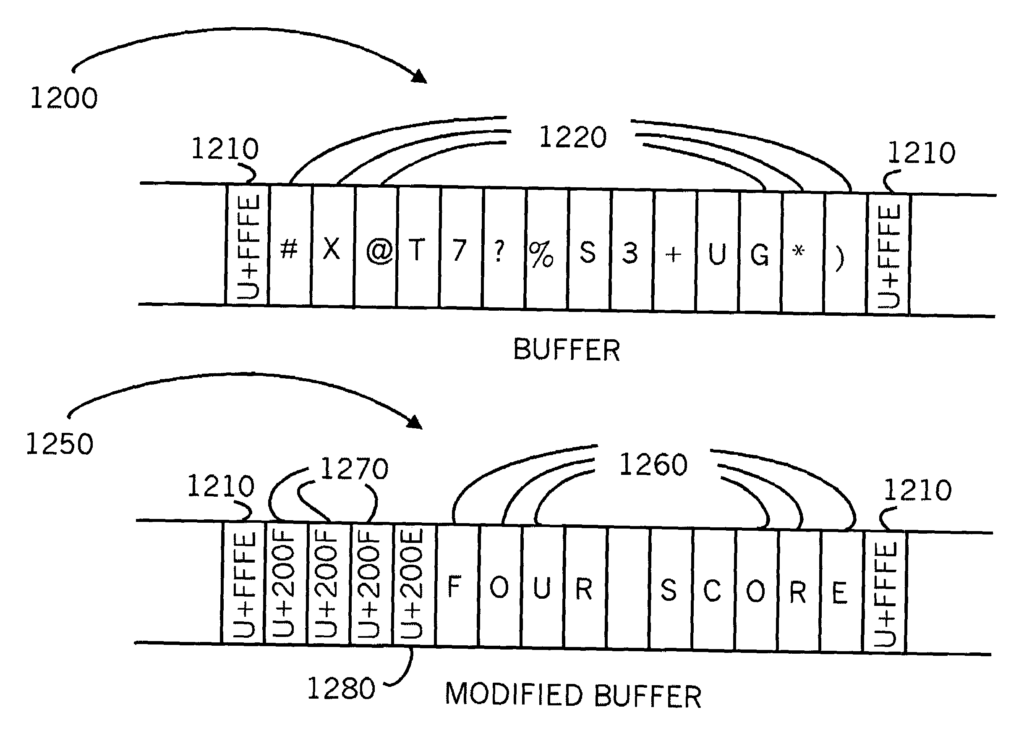
The Kioba Processing LLC invention works as follows
The method involves locating the buffer of memory locations that contains the contents of the formatted page. It also includes locating the first text between two markers in the buffer. This first text is an encrypted text with N characters.
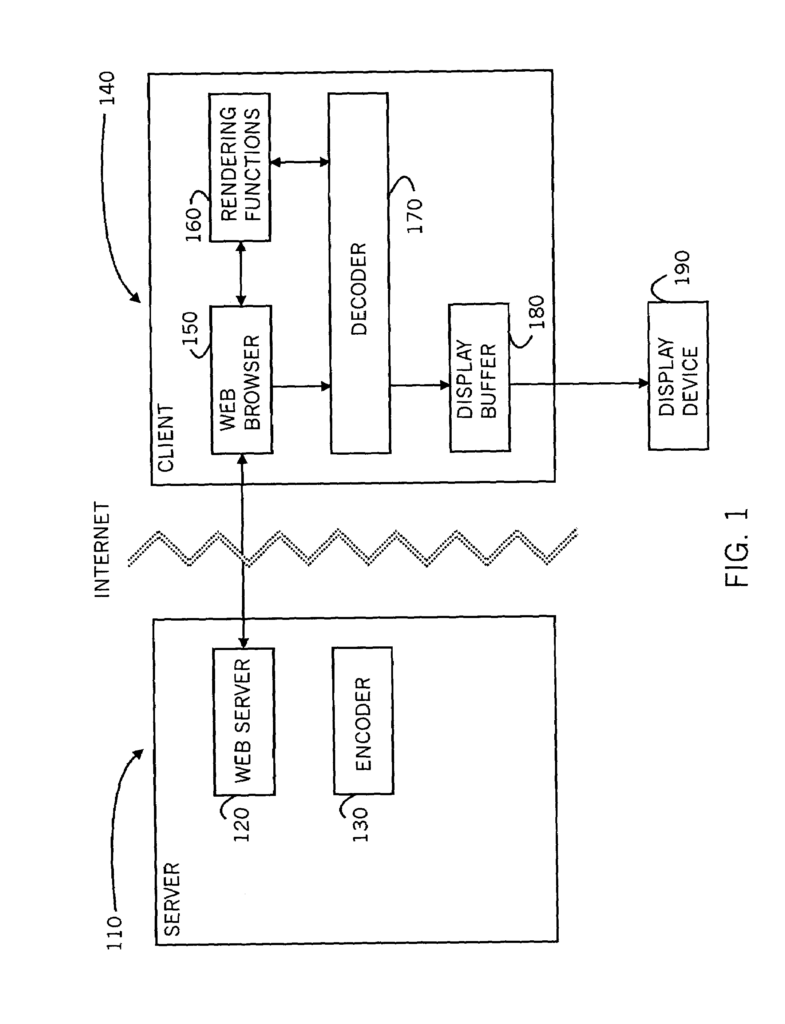
Background for System and method for copy protection of displayed content
Information in the form text and images is often transmitted between computers through files like Microsoft Word documents (documents), Microsoft Excel spreadsheets (spreadsheets), Microsoft PowerPoint slides (presentations), HTML web pages, XML files and other files with text and images. A user can copy text and images displayed on such files using several widely-known methods. A user can, for example, select a text portion with an input device, such as a keyboard or mouse, and then copy it to paste into another document. Another example is that a user could capture the content of a computer screen by using a screen capture and then insert it into another document.
Text on web pages is especially susceptible to being copied. In most cases, HTML-displayed web browsers allow users to view the source files of HTML pages. In the Microsoft Windows operating systems running Microsoft Internet Explorer and Netscape Communicator, a user can select?View source? by clicking on the right mouse button while the mouse is positioned above an HTML page. In most cases, the source file of the HTML page will be displayed in full within a separate window. The user can easily select and copy any text portion from the source document, then paste it in another document.
Adobe’s PDF Reader disables the ability of users to copy text selections. This is a feature that some applications like Adobe’s PDF Acrobat can provide. A user can still capture any part of a PDF displayed on the screen using a simple screen grab.
Many information services generate their revenue by providing clients with valuable information. Financial services, marketing, news and legal services are examples of these services. Such information is also often delivered electronically. With today’s technology a subscriber can copy and email such information to others without having to pay for additional subscription fees.
There is a pressing requirement to find a solution to stop text and images displayed on computers from being copied.
U.S. Pat. No. Lesk’s 5,905,505 describes a method and system based on images for protecting text displayed in a screen. Lesk works on a bitmapped image of the displayed text. Lesk produces two perturbed pictures by adding random bits into the bit-mapped text image. The two perturbed photos are then rapidly interlaced. The user can then see the desired text image by averaging the two perturbed pictures, but only one is shown at a time. “A person copying data off the screen will only get a perturbed picture, which can be difficult to read.
Lesk can be difficult to implement because (1) random bits must be generated so that the average of two perturbed pictures appears ‘clean? Lesk must be practised on a video buffer level for Internet applications. It is also possible to defeat Lesk by taking two screens that contain both perturbed pictures and then averaging the digitally.
There is a need for a more simple and practical method to stop text and images displayed on a screen being copied without permission.
The present invention is a system and method for copy protection, which includes text and images within a page of a document, such as HTML, displayed on a display by a computer. In a preferred implementation, the invention encrypts protected content and decrypts it only when the page that contains the content is rendered to a graphics device. The designated content is protected while off-screen. When the present invention protects text content, a program viewing the source listing or capturing the page of the document can only capture the encrypted text which appears as gibberish.
To complement the off-screen protective, the present invention incorporates preferably the invention described in the assignee’s U.S. No. No. 09/397 331, now U.S. Pat. No. No. 6,298,446, titled?Method for Copyright Protection of Digital Images Transmission over Networks?, filed on Sep. 14th 1999. The invention described in U.S. Ser. No. No. The present invention, combined with the invention described by U.S. Ser. No. No.
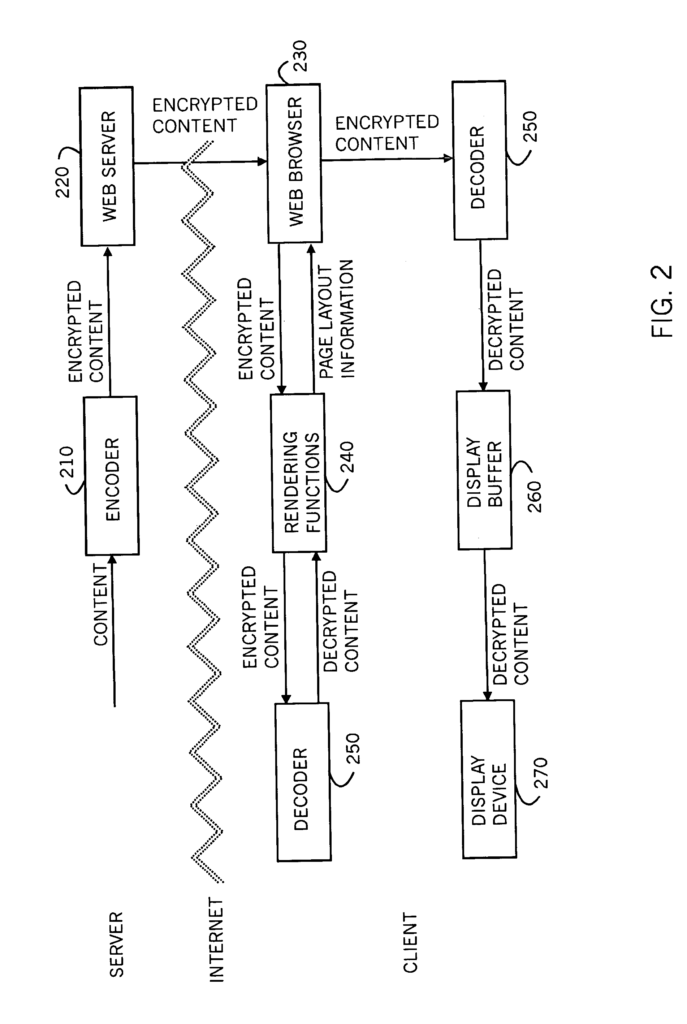
In a preferred embodiment, text and images in HTML pages and other documents are encrypted and decrypted only when they are rendered to a graphics device using system text rendering functions, such as Microsoft Windows TextOut( ), or Macintosh DrawText().
In a general context, the present invention presents a method to protect content rendered and formatted by patchable system calls. The present invention is not limited to text and images, but can also be used to protect audio, video, and other data.
The present invention can be used to protect content in HTML pages and email and, more broadly, enterprise data.
Although the user can view protected content on the screen, it is encrypted at all other levels of the system, except in a display buffer inside a videocard. Conventional encryption technologies such as PGP decrypt encrypted data to a temporary files, which allows a user to view protected content. However, the present invention does not decrypt content at the application-level?only at a display level.
The preferred embodiment of this invention provides a method to alter text displayed on a formatted webpage, which includes locating a memory location buffer containing the contents of the page, finding a text between two markers in the buffer, changing the text with an alternative text string and inserting fill characters into unfilled memory locations in between the markers.
The preferred embodiment of this invention provides a system to alter text displayed on a formatted webpage, which includes a buffer containing memory locations that contain the contents of a page formatted, a search engine that locates a text between two markers in the buffer, and then a text processor that replaces the text with an alternative text string, inserting special fill character in the unfilled memory location between the markers.
The present invention is a system and method for copy protection, which includes text and images within a page of a document, such as an HTML, displayed on a display by a computer. In a preferred implementation, the invention encrypts protected content and decrypts it only when the page that contains the content is rendered to a graphics device. The designated content is protected while off-screen. When the present invention protects text content, a program viewing a source list of a page or capturing a page is only able capture encrypted text which appears as gibberish.
To complement the off-screen protective, the present invention incorporates preferably the invention described in the assignee’s U.S. No. No. 09/397 331, now U.S. Pat. No. No. 6,298,446, filed Sep. 14, 1998, entitled “Method for Copyright Protection of Digital Images Transmission over Networks”, is hereby incorporated by reference. The contents of the above mentioned patent are hereby incorporated into this document by reference. The invention described in U.S. Ser. No. No. The present invention, combined with the invention described by U.S. Ser. No. No.
In general, the invention works by encrypting content that is protected at its source (such as a server computer) and decrypting it only when the content is written into a video display buffer. The application that handles the content in reality is handling encrypted content. Any attempt to copy the content from the app, for example by copying files or attaching them to an email, will only reveal encrypted content.
Protected Content is Exposed when it is written into a Display Buffer for display, and while in the Display Buffer, it is Protected using the applicant’s invention, as described in U.S. Ser. No. 09/397,331.
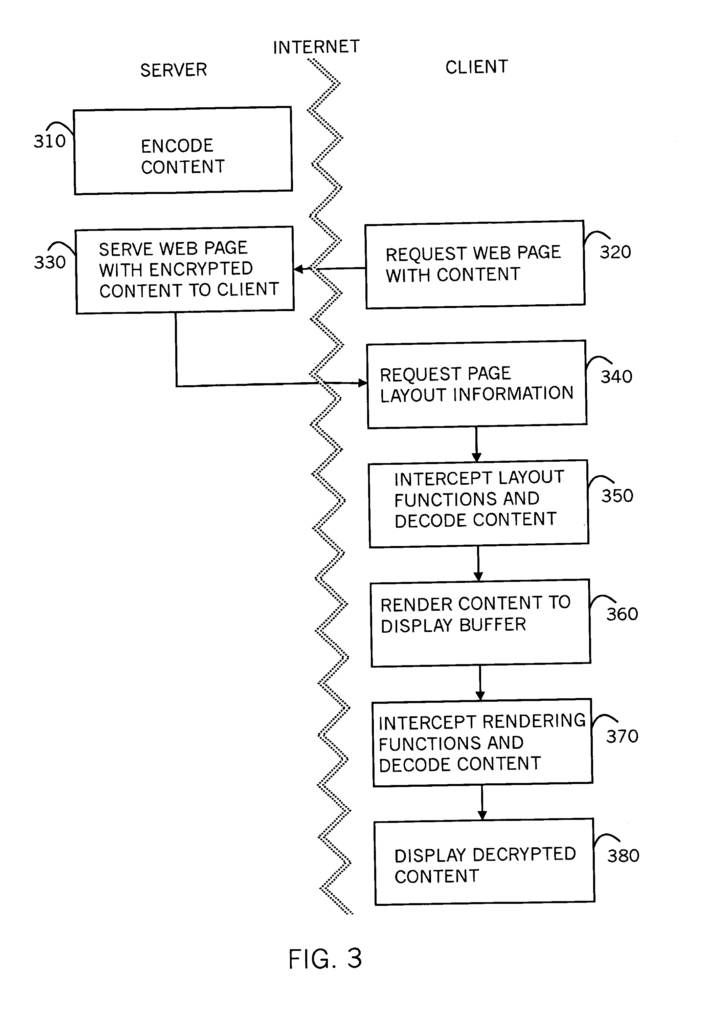
Refer to FIG. This is a simplified illustration of a system for protecting content in accordance with the preferred embodiment of this invention. In FIG. In FIG.
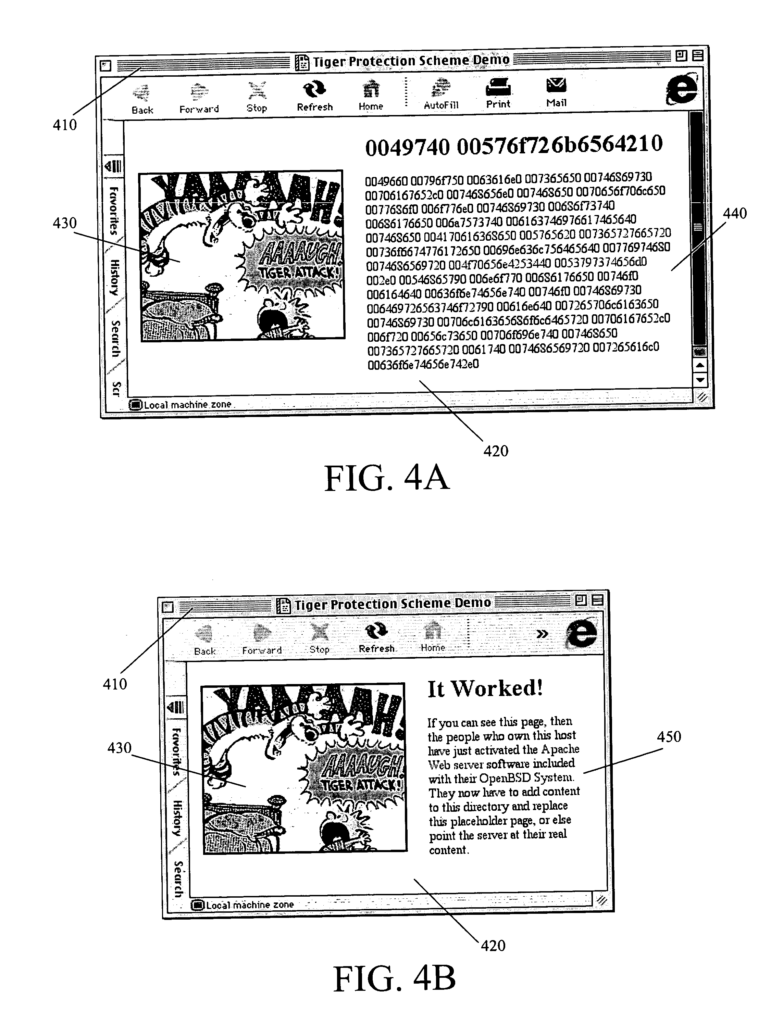
Click here to view the patent on Google Patents.
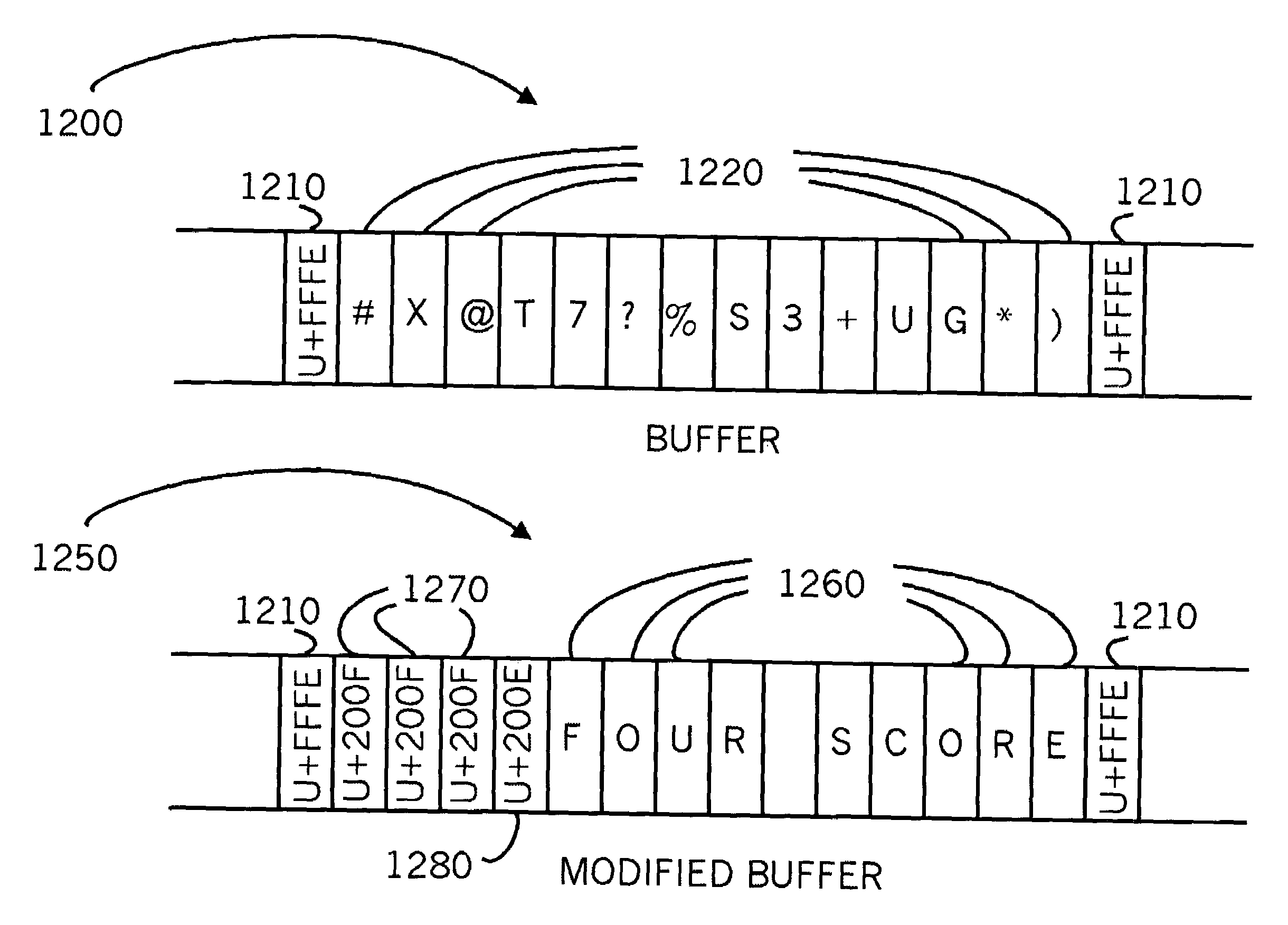
Leave a Reply